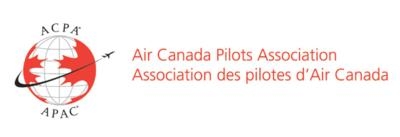Thu, Sep 27, 2018
The Air Canada Pilots Association Calls On Canadian Government To Close The Two-Hour Gap To Protect Canadian Passengers
The Air Canada Pilots Association (ACPA) has endorsed recommendations made by the U.S. NTSB, which calls on the Government of Canada to fix its outdated fatigue regulations to ensure the safety of Canada's passengers and pilots.

"We thank the NTSB for their comprehensive review," said Captain Matt Hogan, Chair of ACPA's Master Elected Council. "Their findings on fatigue underscore the many years of urgent calls by Canada's pilots for flight crew fatigue rules that are supported by science. The government's proposed rules fall short; they would allow Canadian pilots who begin their duty at 9 pm to operate two hours longer than NASA research recommends, and even long than would be permitted in the United States. Canada's new fatigue rules must close this two-hour gap."
NASA's Ames Research Center and others conducted research that measured brain wave activity and micro-sleeps of pilots in actual flight operations at night. This informed NASA's recommendation of a maximum night duty of 10 hours of duty – or 8.5 hours of flight time – at night, requiring a relief pilot for longer duty periods. These NASA recommendations were not reflected in the draft regulations released by Transport Canada on July 1, 2017.
ACPA has joined other pilot groups in calling on the Canadian government to stop years of delays and fix the flawed regulations, including by taking the following steps:
- Address pilot fatigue on long-haul flights at night by limiting duty periods for flights in the evening to 8.5 hours of flight time – in line with NASA research findings;
- Ensure that any Fatigue Risk Management System relies on science-based prescriptive limits as a foundation, requiring independently verifiable data and stringent Transport Canada approval and oversight before deviating from the maximum duty period; and,
- Pilots on all sizes of aircraft – whether they carry passengers or cargo – should have the same protective fatigue limits, implemented at the same time.
ACPA formed the Safer Skies coalition in 2017, bringing together the voices of 9,000 airline pilots in Canada who work every day to keep their passengers and the skies safe.
(Source: ACPA news release)
More News
Terminal Radar Service Area Airspace surrounding designated airports wherein ATC provides radar vectoring, sequencing, and separation on a full-time basis for all IFR and participa>[...]
Aero Linx: Utah Back Country Pilots Association (UBCP) Through the sharing experiences, the UBCP has built upon a foundation of safe operating practices in some of the most challen>[...]
From 2010 (YouTube Edition): Imagine... Be The Change... Inspire FROM 2010: One of the more unusual phone calls I have ever received occurred a few years ago... from Anousheh Ansar>[...]
(Pilot) Felt A Shudder And Heard The Engine Sounding Differently, Followed By The Engine Chip Detector Light On April 14, 2025, about 1800 Pacific daylight time, a Bell 206B, N1667>[...]
Also: AMA Names Tyler Dobbs, More Falcon 9 Ops, Firefly Launch Unsuccessful, Autonomous F-16s The Air Force has begun ground testing a future uncrewed jet design in a milestone tow>[...]
 ANN's Daily Aero-Term (05.07.25): Terminal Radar Service Area
ANN's Daily Aero-Term (05.07.25): Terminal Radar Service Area ANN's Daily Aero-Linx (05.07.25)
ANN's Daily Aero-Linx (05.07.25) Classic Aero-TV: Anousheh Ansari -- The Woman Behind The Prize
Classic Aero-TV: Anousheh Ansari -- The Woman Behind The Prize NTSB Prelim: Bell 206B
NTSB Prelim: Bell 206B Airborne-NextGen 05.06.25: AF Uncrewed Fighters, Drones v Planes, Joby Crew Test
Airborne-NextGen 05.06.25: AF Uncrewed Fighters, Drones v Planes, Joby Crew Test



